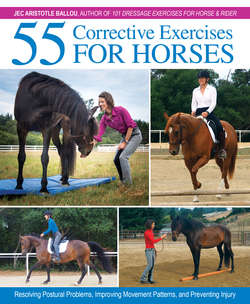Читать книгу 55 Corrective Exercises for Horses - Jec Aristotle Ballou - Страница 18
На сайте Литреса книга снята с продажи.
EXERCISE 4: Quick Halts Down a Hill
Оглавление| PURPOSE: | Lifts the base of the horse’s neck and lightens the forehand. |
The base of the horse’s neck (at his chest) stores a large number of proprioceptors (nerves that read and cue movement). How a horse uses this area of his body while moving, therefore, determines whether his hindquarters can engage well or not. If he constantly “falls forward” with his chest and pushes weight down into the base of his neck, he will be capable only of stiff strides and a rigid back. This pattern becomes deeply embedded.
On the other hand, if he lifts the base of his neck while traveling forward, he creates a reflexive reaction system-wide that lightens his forehand and allows his hind limbs to swing forward and balance under his body. Use this exercise to target these proprioceptors at the base of his neck.
1 Develop a brisk walk on light rein contact traveling straight down a hill.
2 The hill should be adequately sloped so you feel the horse working his way down it, but not so steep that he is scrambling.
3 After 10 or so strides, ask for an abrupt halt transition (fig. 1.6). Be sure the horse stands straight and does not swing his hindquarters to the side.1.6: Diamante learns to flex his hind joints and balance his weight on his hindquarters when I ask him to stop quickly while walking downhill.
4 Stand still for 5 seconds. Then proceed in walk again. Remain perfectly straight.
5 Repeat, walking 10 strides and making an abrupt halt.
When you stop your horse, keep your rein contact. It’s important that he stays in a good posture rather than sticking out his neck or lifting his head. As soon as you ask for the halt, you want him to stop abruptly. This causes him to sink downward with his sacrum and hold the flexion of his hind legs so he can lighten his front end.
